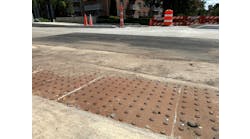Kansas City will start running buses on the shoulder of I-35 between Olathe, Kan., and downtown, the Kansas City Star reported.
The service, while it will only save three to five minutes on average per trip, is intended to give passengers a more reliable route between downtown and the suburbs, and transit planners hope that it will lure travelers away from their cars
“If you have a lot of traffic, a trip that’s now 15 or 20 minutes late might only be five minutes late,” said Shawn Strate, a transit planner for Johnson County, in which Kansas City is located. “During times of really heavy congestion, we can see time savings of 10 to 15 minutes.”
The new service is a variation of the bus rapid transit routes that serve other parts of Kansas City. The key difference will be that this service will have a slight edge over a car when traffic gets bad.
Buses will be able to run on the shoulder of I-35 when highway traffic slows to less than 35 mph, but cannot travel at more than 35 mph, and not more than 10 mph faster than the flow of highway traffic. Other rules: Buses must always yield to other vehicles entering and exiting the highway, and must drive around shoulder obstructions such as a disabled car or debris. Other vehicles are barred from following the bus along the shoulder.
The startup costs of the new bus service will be about $2 million, which will come from federal money that had been designated for commuter rail planning. Congress approved the redirection of the money to the bus-on-shoulder service.
This is a scaled-down plan; originally, a $20 million plan called for adding new buses and building many bus shelters and park-and-ride lots. Seven or eight bus shelters will still be built and will feature real-time signs indicating when the next bus will arrive.
The bus-on-shoulder service was born out of years studying how to run commuter trains on existing railroad tracks from Olathe to downtown. At one point in 1995, it appeared feasible. But the cost ballooned to more than $300 million after the railroad company insisted on track improvements if the county wanted to use the rails for commuter trains.
The new bus service is similar to services operated in Cincinnati, Miami, Minneapolis, Atlanta, Seattle and the Washington, D.C., suburbs in Virginia and Maryland.


